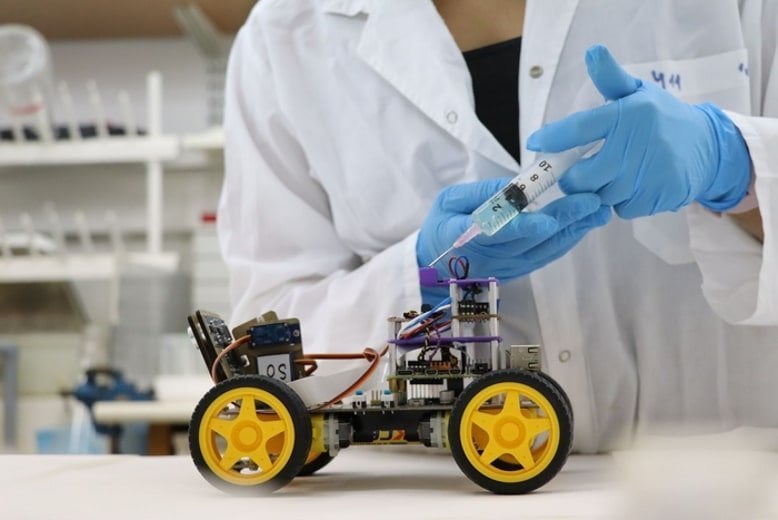Summary: A new biological sensor sends electrical information in response to the presence of an odor which the robot is able to detect and interpret.
Source: Tel Aviv University
A new technological development by Tel Aviv University has made it possible for a robot to smell using a biological sensor. The sensor sends electrical signals as a response to the presence of a nearby odor, which the robot can detect and interpret.
In this new study, the researchers successfully connected the biological sensor to an electronic system and using a machine learning algorithm, were able to identify odors with a level of sensitivity 10,000 times higher than that of a commonly used electronic device.
The researchers believe that in light of the success of their research, this technology may also be used in the future to identify explosives, drugs, diseases, and more.
The biological and technological breakthrough was led by doctoral student Neta Shvil of Tel Aviv University’s Sagol School of Neuroscience, Dr. Ben Maoz of the Fleischman Faculty of Engineering and the Sagol School of Neuroscience, and Prof. Yossi Yovel and Prof. Amir Ayali of the School of Zoology and the Sagol School of Neuroscience.
The results of the study were published in the prestigious journal Biosensor and Bioelectronics.
Dr. Maoz and Prof. Ayali explain: “Man-made technologies still can’t compete with millions of years of evolution. One area in which we particularly lag behind the animal world is that of smell perception.
“An example of this can be found at the airport where we go through a magnetometer that costs millions of dollars and can detect if we are carrying any metal devices. But when they want to check if a passenger is smuggling drugs, they bring in a dog to sniff him.
“In the animal world, insects excel at receiving and processing sensory signals. A mosquito, for example, can detect a 0.01 percent
difference in the level of carbon dioxide in the air. Today, we are far from producing sensors whose capabilities come close to those of insects.”
The researchers point out that, in general, our sensory organs, such as the eye, ear and nose – as well as those of all other animals – use receptors that identify and distinguish between different signals. Then, the sensory organ translates these findings into electrical signals, which the brain decodes as
information. The challenge of biosensors is in the connection of a sensory organ, like the nose, to an electronic system that knows how to decode the electrical signals received from the receptors.

Prof. Yovel: “We connected the biological sensor and let it smell different odors while we measured the electrical activity that each odor induced. The system allowed us to detect each odor at the level of the insect’s primary sensory organ. Then, in the second step, we used machine learning to create a ‘library’ of smells.
“In the study, we were able to characterize 8 odors, such as geranium, lemon and marzipan, in a way that allowed us to know when the smell of lemon or marzipan was presented. In fact, after the experiment was over, we continued to identify additional different and unusual smells, such as various types of Scotch whiskey.
“A comparison with standard measuring devices showed that the sensitivity of the insect’s nose in our system is about 10,000 times higher than the devices that are in use today.”
Dr. Maoz concludes: “Nature is much more advanced than we are, so we should use it. The principle we have demonstrated can be used and applied to other senses, such as sight and touch.
“For example, some animals have amazing abilities to detect explosives or drugs; the creation of a robot with a biological nose could help us preserve human life and identify criminals in a way that is not possible today. Some animals know how to detect diseases. Others can sense earthquakes. The sky is the limit.”
In future work, the researchers plan to give the robot a navigation ability to allow it to localize the odor source and later, its identity.
About this robotics research news
Author: Noga Shahar
Source: Tel Aviv University
Contact: Noga Shahar – Tel Aviv University
Image: The image is credited to Tel Aviv University
Original Research: Open access.
“The Locust antenna as an odor discriminator” by Ben Maoz et al. Biosensor and Bioelectronics
Abstract
The Locust antenna as an odor discriminator
Identifying chemical odors rapidly and accurately is critical in a variety of fields. Due to the limited human sense of smell, much effort has been dedicated to the development of electronic sensing devices.
Despite some recent progress, such devices are still no match for the capabilities of biological (animal) olfactory sensors, which are light, robust, versatile, and sensitive. Consequently, scientists are turning to a new approach: Bio-Hybrid sensors.
These sensors combine animal biological sensors with electronic components to achieve maximum detection and classification while conveying a comprehensible signal to the end user.
In this work, we created a bio-hybrid odor discriminator utilizing the desert locust’s primary olfactory apparatus – its antennae, together with simple electroantennogram technology and artificial intelligence tools for signal analysis.
Our discriminator is able to differentiate between at least eight pure odors and two mixtures of different odorants, independently of odorant concentration.
With four orders of magnitude higher sensitivity than gas chromatography–mass spectrometry, it is able to detect the presence of less than 1 ng of volatile compounds and, compared to other bio-hybrid sensors available today, it can be easily operated by an unskilled individual.
This study thus opens up the future for robust and simple bio-hybrid robotic sensing devices that can be widely deployed.






